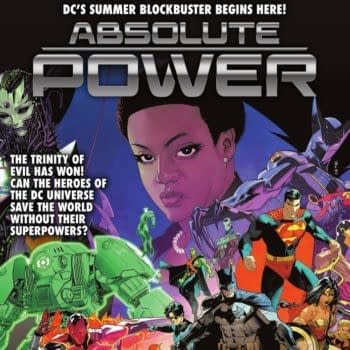Posted in: Comics | Tagged: kickstarter
How To Succeed At Kickstarter. From Someone Who Did.
Alex Woolfson writes;
I'm going to tell you how to succeed with Kickstarter. I'm going to tell you this in part because I'm looking to spread the word about my currently-running Kickstarter project: The Young Protectors Volume One, but mainly because I think that crowdfunding is the most effective (and most fun) way for people like you and me to get the large amounts of money we need to make awesome stuff.
WHAT GOT ME STARTED WITH KICKSTARTER
First, a little bit about why you should listen to me. To start, I'm just a regular guy with a somewhat regular day job as a freelance video editor. As a gay kid growing up, I loved action films and superhero comics, but I never got to see what I really wanted to see—and that's kick-ass genre stories with heroes, real heroes, who just happened to like other guys. I wanted those stories to feel just as slick and professionally produced as the big budget stories I saw with straight heroes and it soon became clear that if I really wanted to see that, I was going to have to create those stories myself.
Maybe you have a dream like that too. Some story burning inside you, something you know that other people would want to see just as much as you, but you also know that no major corporation will ever pay you to make it the way you know it should be made or even just fund the printing of it. And let's face it, credit cards can only take you so far. That's where I was when I had finished the one-year run of my first webcomic, the gay science-fiction thriller Artifice , and tried to bring it to print as a premium-quality graphic novel by raising funds through Kickstarter.
How'd that work out for me? With Artifice, I was trying to raise $7,000 in 30 days. By the end of the 30 days, I had raised $36,551, over 500% of my goal. After that book had been printed, sent out to my backers and was available for sale at Amazon, I decided to try the same thing with my currently running gay superhero webcomic, The Young Protectors , this time asking for $14,000 in 30 days and trying to make use of what I learned on the last Kickstarter.
What happened? We raised that $14,000 in the first 18 hours and as I write this, 15 days in, we've raised over $65,000.
That's right. Tens of thousands of dollars. For a gay superhero comic. Hard to get more "niche" than that and yet I'm going to be able to print a gorgeous softcover of it, thousands of copies, exactly how I want to. And that's not even mentioning the pro-quality trading cards of my characters and a bunch of other goodies I'm going to be able to create due to the exceptional success of the project. All of that's real. All of that is now going to happen.
And if I can do it, you can do it too.
KICKSTARTER SECRETS
Kickstarter has some great tutorials about the basics, such as coming up with a compelling video for your project. You should check those out. But what I'm going to offer here are some secrets I've learned along the way, secrets that I think really make the biggest difference in whether you fail or succeed spectacularly.
(Oh, and if you don't know about what Kickstarter is, here's a quick run-down: as a project creator, your goal must be a creative project that can be completed by raising a specific amount of money. "Backers" pledge different amounts of their money at different "pledge levels" in exchange for the promise of clear, tangible rewards from you. No one's credit card is charged until the project deadline is reached and backers can change or cancel their pledges at any time until then. There's no limit to the amount of money you can raise while your project is running but if you don't raise the amount you're asking for, the whole thing is called off—backers' credit cards won't be charged, you get nothing but you also won't have to provide any rewards to anyone. Which is good because you wouldn't have enough money to make and ship those rewards anyway. It's a smart set up—win-win for everyone and as safe as backing a speculative creative venture can be.)
BUILD AN AUDIENCE OF FANS AHEAD OF TIME
I'm going to start right off by telling you something you don't want to hear. If you want to really succeed, you're going to need to put in work ahead of time, like at least a year, building up an audience of fans who appreciate your work. If you don't put the time in on this, the chance of anyone even hearing about your project outside of your friends and family is slim. And if you're looking to raise more than a few thousand dollars, you're going to need lots of complete strangers to believe in you and what you're doing.
If you come into a project with an already installed fanbase—people who not only want to see you succeed but actually love your work—fantastic things happen quickly and you can actually be weak in other areas of your project and it won't matter. I've seen a project with a completely incomprehensible project video raise over $50,000 in a couple days because that creator had a huge number of hardcore fans who believed in them, loved their work and desperately wanted a book. Building an audience who already want what you're trying to fund is the most important thing you can do and will be the biggest factor in how quickly you reach your goal and whether you will reach your goal at all. Let's face it, a Kickstarter is a terrible way to introduce yourself to the world. You're basically saying "hello" while holding your hand out looking for cash. Crowdfunding can be a party, but how would you react if you met someone at a party who did that?
If you want to meet your goal, if you want that essential word-of-mouth to happen, you should start your project with a bunch of people who already want what you're trying to fund. The good news is that there's a great way for regular comic creators like you and me to make that happen: webcomics.
BUILD THAT AUDIENCE BY RELEASING YOUR PAGES FOR FREE AS A WEBCOMIC
As a webcomic creator, you put out pages on a regular schedule (ideally weekly or more) which creates an excuse for both you and your readers to post about it using social media on a regular basis—and it's that kind of persistent momentum that pulls in more new readers. (I myself refused to read webcomics for years—A page a week? Sounds like torture!—until a friend of mine tweeted about page updates for the same comic every week for over 30 weeks until finally I was like: "All right! I'll look at the darn thing!" And then I was hooked. And then I knew that's how I needed to release my own work.)
Also, half the fun of webcomics for readers is the community that forms discussing each new page in the page comments; this can give your work some real "stickiness" in terms of building fans. And finally, for those thinking of crowdfunding, if you as the comic's creator participate in those discussions in the comments, your readers get to know you—you're no longer some stranger, you're one of them—and if you consistently post your pages on time every week, then you also show that you can be trusted to deliver what you promise. That matters if someone is going to give you their hard earned money for a speculative creative project.
If you want to bring your comic to print and you don't already have an installed fanbase, I strongly recommend releasing it a page a week on the web for at least a year. If nothing else, by keeping an eye on your stats, you'll know exactly how appealing your work is before you put in the tremendous amount of work a Kickstarter requires. (Knowing that I had 5000 unique visitors a day with Artifice before I launched gave me a lot of confidence.) You'll be able to adjust things if it doesn't have the appeal you're looking for. And frankly, releasing your work as a webcomic is tremendously gratifying, especially because of that continuous reader interaction and feedback.
Crowdfunding is a great example of new technology giving the little guy an unprecedented chance to get support from a worldwide audience of complete strangers. Webcomics have the same power. Take advantage of it.
CHOOSE A REALISTIC GOAL
There's a lot of discussion about how to "game' the amount of money you should ask for with your project. Do you shoot high and take advantage of your backers desperation to see you funded before the clock runs out? Or do you shoot low, increase your chances of "success" and maybe have the opportunity to crow about how far and how fast you exceeded your goal in press releases?
I talk more about mindset below, but by my lights, this is thinking about things the wrong way. Despite what you may have heard, a Kickstarter isn't a pay-day (trust me, all the money you raise is going to go into that book) and it certainly isn't a lottery—rather, it's an opportunity for a bunch of people, including yourself, to get together to bring something awesome into the world that wouldn't be able to happen any other way. So, with that in mind, your goal should be the bare minimum you need to make your book happen. Don't get greedy here—an unrealistic goal can at best make you seem clueless and at worst arrogant. But don't undersell either—you have a moral responsibility to deliver your book to your backers if you succeed and your goal needs to account for not only printing fees but also Kickstarter and payment processing fees (nearly 10%!), taxes (your funding will be taxed as income) and, even more devastating, shipping fees, which can run into tens of thousands of dollars. (Your mind will be blown by how much it costs to ship a heavy thing like a book, especially to international destinations. Yes, you get to add in an extra amount to pledge levels for international backers to cover shipping—and don't make the mistake of shortchanging yourself here!—but that extra amount actually counts towards you reaching your goal, so you can't take it for granted when coming up with that goal.)
You took the time to build an audience. Take the time to crunch all the numbers for what you'll be on the hook for if you succeed. Add at least 15% contingency to that because, let's face it, stuff happens and what you wind up with should be your project's dollar goal.
HAVE THE RIGHT MINDSET
Already have your fanbase? Crunched all the numbers for your goal? Awesome. Here's the real secret for crowdfunding success: if you really want your Kickstarter project to succeed, your first and last thought should be about providing value for your backers. I know a lot of creators who go into a Kickstarter project with what I'd call "donation thinking"—meaning that they approach a crowdfunding project with the idea that they're trying to get folks to 'donate' to them or their project, like they're a charity. And while I do think it's important that your goal be something that actually adds some value to the world in general, my opinion is that 'donation thinking' is wrong-headed. It makes you think that a Kickstarter project is all about you. When it's not. Not if you want to succeed, anyway. It has to be about the backers and creating things that matter to them. And ideally, finding ways for them to have as much fun with the process as you, the creator, are going to have. It's about offering rewards that are at least as valuable as what those backers would get for the same money in a store.
CREATE TEMPTING REWARDS
There are two parts of creating these valuable rewards. First of all, you have to be making something other people would actually want and, when you talk about it in your project description and your video, you need to make sure you're clear enough about what's cool about it so strangers can immediately understand that it's for them. That's the no-brainer. (Take a look at the video on my Kickstarter page for how I approached this.)
But the piece that a lot of project creators seem to miss is in how to "price" these rewards. Again, because of "donation thinking", they'll make the first tangible reward, let's say a book, available at a $50 pledge level. At the most common pledge level, $20, they might offer a PDF download of the book. No, no, no! A small handful of people will believe in you enough that they'll actually want to pay extra to be essentially your "patron"—and for those people, you'll come up with very special high dollar pledge rewards—but the majority of folks visiting your page are just looking to get a cool book for a fair price. As a rule of thumb for rewards under $60, you should "charge" what a backer would pay at retail and ideally less. So, for example, if you plan to sell your graphic novel for $20 retail, then that's the pledge level you should offer it at and with free U.S. shipping. Think of rewards as pre-sales, not as charity.
For higher level rewards, if someone is willing to part with more than $60 or so, then they are still looking for awesome value, but they probably believe a lot in what you're doing, which has value in itself, so the rewards can be less tangible and less "competitively" priced. Here you can offer custom prints, Kickstarter-exclusive keychains, a chance to appear in the comic, whatever you think would be truly tempting to someone who wants to see your book made. And this is, of course, in addition to all the rewards you've offered backers at the lower pledge tiers. (Take a look at the right sidebar of my project to see what rewards I'm offering and how many people chose them so far.)
Also, one thing I learned is that it's a good ideal to have some very high dollar pledge levels, like $1000+, for the handful of folks with resources who really believe in what you're doing. So long as the associated rewards seem truly special, it can't hurt to offer them and in my case, I've been delightfully surprised to find out there are folks willing to pledge even at the $2500 level to support what I'm trying to do.
Finally I'll give one more plug for releasing your work as a webcomic first: I think Kickstarter is actually a perfect fit for webcomic creators looking to go to print. What I see doing the best on Kickstarter is when there's a nice physical artifact that will be created as a reward for backers. With webcomics, readers get to enjoy the entire story for free online—so they can know for sure that they like it—but ultimately, it's much more pleasurable to read a comic (or any art book) in printed form. So, bringing a webcomic to print is sort of the ideal "freemium" model—consumers get to enjoy something of real value for free, no strings attached, and then pay a little bit extra if they want something even better. Bringing a webcomic to print automatically adds value for your readers and that's what coming up with rewards is all about.
MAKE IT FUN
Kickstarter projects tend to raise a lot of money in the first few days and then again in the last few days as the deadline approaches. If you're not careful, it will stall in the middle and as a "little guy", non-celebrity creator, you can't afford that. What you want is momentum. And so after you've created the tempting pledge level rewards, you should create even more tempting "stretch goals"—additional funding targets above your original goal—that make what all backers are going to get even more awesome.
For example, with The Young Protectors Volume One Kickstarter Project, my original goal was $14,000. That meant the book would get printed. But if we hit just a thousand dollars above that, $15,000, I said I'd create a pro-quality 2.5" x 3.5" printed trading card of one of my characters and include it with that book. And for every $2500 beyond that which we raised, I offered another trading card, which has meant that every day the package of rewards have gotten better for my backers. At $25,000, I added another 11" x 14" print option for those getting prints and all backers will have the opportunity to download the art as a high-res wallpaper. Other stretch goals included a 25-page bonus comic added to the book, flying my colorist up from Argentina to sign books and even creating art to send out to backers with (very tasteful) full-nudity of my adult characters, something I'll never do in my webcomic.
The stretch goals you come up with should be special things that folks will really want to make happen and they should ideally benefit every single backer when they are unlocked. Basically, the more stretch goals that get unlocked, the better the rewards for everyone—a great recipe for building momentum and word-of-mouth. It's why they're so popular with Kickstarter project creators. (To see the stretch goals I've come up with, scroll down my project page to the section marked "Stretch Goals.")
MAKE IT INTERACTIVE
But I think there's a way to do one better on this. Because I had thought I might create another Kickstarter after the success with the Artifice Kickstarter, I've kept my eye out, looking for other creators doing smart things with their projects. And a few months back, there was this wildly successful project by creator Ryan North that I thought did some very smart things. For one, it had a brilliant physical reward—a Choose Your Own Adventure book of Hamlet! How cool is that! But he also had this very engaging interactive component to his campaign: backers could actually guide a sample Choose Your Own Adventure story through daily votes in the Comments section of the project (and then he'd reveal the page that resulted from their choice in the next Backer Update). That's actually how I heard about that campaign and became a backer—while I was at a BBQ, I overheard a bunch of folks talking about how much they were enjoying participating in that.
So, when it came time to design this new campaign, I also wanted to include an interactive element, to make it more fun and engaging for the backers. What I came up with were 24-hour voting surveys for each of the stretch goals we hit, where readers get to vote on which character will be featured on the next trading card, which two characters they want to see kissing in the next bonus print, even whether they want a a reward to be a Not Safe For Work-level of sexy. I've been surprised about how passionate backers have been about their choices! And I've heard repeatedly in the comments that this is "the most fun Kickstarter" a backer has been part of.
And that's what you want: your backers to feel as passionately engaged with this project as you are so they stay involved and talk to their friends about it.
ALWAYS REMEMBER, IT'S ABOUT THE BACKERS, NOT YOU
It's OK to dream big. To plan for awesome success. You should absolutely be passionate about your work and share that passion with the world and your backers with your Kickstarter project. Just don't think of crowdfunding like the lottery where tens of thousands of dollars is just a lucky break away. See a Kickstarter project for what it is: an incredibly democratizing resource for the little guy to access a world-wide audience of potential buyers and supporters in order to create something a lot of folks would love to have if only they knew about it.
Back a bunch of projects so you know firsthand, as a backer, what works and what doesn't. Spend at least a year ahead of time building an audience of folks who believe in what you're doing. Figure out the minimum you'd need to create that wonderful thing. Take a moment to check out how I set things up in my project (and if you like what I'm trying to do, consider joining the fun and backing my project!) And then design a campaign that would make you, yourself, leap over a fence to pledge, especially at the most popular $20-$30 level.
And then let me know all about your awesome Kickstarter success so I can pick up tips from you for my next Kickstarter project! Good luck!












